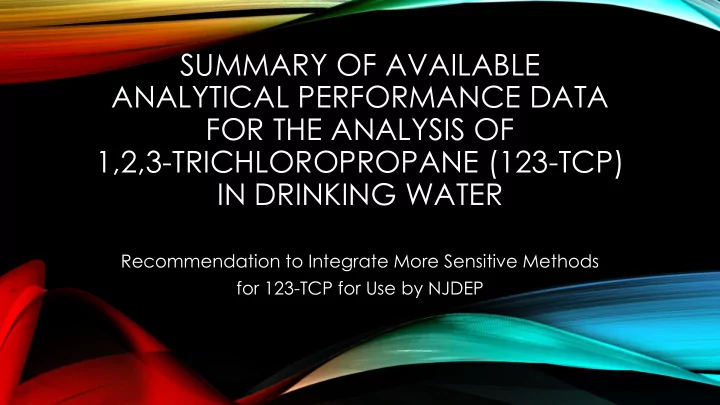

SUMMARY OF AVAILABLE ANALYTICAL PERFORMANCE DATA FOR THE ANALYSIS OF 1,2,3-TRICHLOROPROPANE (123-TCP) IN DRINKING WATER Recommendation to Integrate More Sensitive Methods for 123-TCP for Use by NJDEP
WHY DO WE CARE ABOUT 1,2,3-TCP? • The chemical, 1,2,3-TCP, is a man-made and persistent substance that was previously found as an ingredient/impurity in soil fumigants applied to agricultural land, and used in industrial processes, for paint removal, and other purposes. • It has been classified as likely to be carcinogenic to humans by the United States Environmental Protection Agency. • NJDEP proposed an MCL for 1,2,3-TCP because it is a potent genotoxic carcinogen which occurs in drinking water at levels resulting in significant cancer risk based on test results from New Jersey public and non-public water supplies.
STEPS TAKEN FOR 1,2,3-TCP • The DWQI Health Effects Subcommittee developed a Health-based MCL of 0.0013 µg/L (1.3 ng/L); October 5, 2016 • However, this Health-based MCL was not achievable using current analytical methodology • The DWQI Testing Subcommittee developed a 0.030 µg/L Practical Quantitation Level (PQL), which would be the regulatory compliance level
Proposed Amendments to NJ Safe Drinking Water Act Regulations (NJAC 7:10) (August 7, 2017) Include Proposed MCL for 1,2,3-TCP “The Department is proposing that the threshold for quarterly monitoring for 1,2,3 -TCP be established at 0.010 μg/l , the concentration that is the median of the method detection limits for 18 of the 21 laboratories whose performance data were analyzed by the Institute for the determination of the PQL for 1,2,3- TCP.” The two analytical methods used for 1,2,3-TCP are USEPA Methods 504.1 and 524.3. • Issue: USEPA Method 504.1 has a published MDL of 0.020 μg/l • Issue: The equivalent USEPA Method 524.3 is not as sensitive in the full scan mode The Department is also proposing amendments to the PWTA rules at N.J.A.C. 7:9E-2.1 to require testing for 1,2,3-TCP, ethylene dibromide (EDB), and 1,2-dibromo-3- chloropropane (DBCP) statewide starting 180 days after the amended rules are effective (to allow laboratories time to purchase equipment, train staff, and obtain certification in New Jersey, as necessary);
SUMMARY OF THE CALIFORNIA ANALYTICAL STUDY OF 1,2,3-TRICHLOROPROPANE (123TCP) IN DRINKING WATER GOAL (2018): Evaluate available analytical methods to regulate 1,2,3- TCP to levels below 30 parts-per-trillion (ppt) and consistent with California standard of 5 ppt. * California Water Boards, DIVISION OF DRINKING WATER (DDW) PROGRAM MANAGEMENT BRANCH January 31, 2018
CA-ELAP Certified Laboratories That Responded to Phone Inquiry of Current Method Performance Data Low Point MDL MDL*5 Calibration Reporting CA-ELAP Certified Laboratory name (ng/L) (ng/L) (ng/L) Limit (ng/L) Analytical Method ALS Environmental, Kelso, CA 1.2 6 5 5 524M-TCP American Water Central Laboratory, 4.0 20 2.5 5 524.3SIM Belleville, IN Eurofins Calscience, Inc., Garden Grove, CA 1.3 6.5 5 5 524M-TCP Eurofins Eaton Analytical Inc., Monrovia, CA 0.68 3.4 4 5 524M-TCP Test America, Irvine, CA 1.2 6 5 5 524M-TCP City of San Diego Water Quality Laboratory, San Diego, CA 1.8 9 5 5 524M-TCP Eurofins Eaton Analytical, Inc., South Bend, IN 1.0 5 5 5 524.3SIM 1.2 6.0 5.0 5.0 MEDIAN 1.6 8.0 4.6 5.0 MEAN
CONCLUSIONS DRAWN FROM AVAILABLE PERFORMANCE DATA • Standard Reference Materials (SRMs) were used for all participating laboratories at 5 ppt to establish valid calibration at that level • Two of the laboratories surveyed indicate that they have low-point calibration below 5 ppt • The number of laboratories in this more recent survey indicated that 5 ppt is achievable on a routine basis
COMMENTS ON TWO METHODS • California ELAC Method 524M-TCP can achieve 5 ppt. However, • NJDEP Office of Quality Assurance (OQA) does not currently offer certification for this method • It is a single parameter method • CA-ELAC is not recognized nationally, and OQA would require performance data to establish capability for certification. • USEPA Method 524.3 operated in the optional selected ion monitoring (SIM) mode can achieve 5 ppt. • NJDEP OQA currently offers certification for this method • Certified laboratories use the full scan mode which is less sensitive; therefore would need to use SIM
NJDEP RECOMMENDATION • The Department can establish a PQL at the demonstrated Reporting Limit of the California study of 5.0 ppt. • Recommend use of 524.3 SIM since OQA-certified laboratories are already certified for 524.3, which includes the use of the SIM mode option
Recommend
More recommend